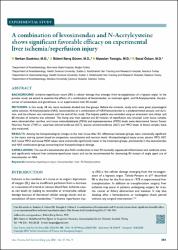| dc.contributor.author | Suakıtıcı, Serkan | |
| dc.contributor.author | Güven, Bülent Barış | |
| dc.contributor.author | Tanoğlu, Alpaslan | |
| dc.contributor.author | Özkan, Sezai | |
| dc.date.accessioned | 2021-08-02T08:29:57Z | |
| dc.date.available | 2021-08-02T08:29:57Z | |
| dc.date.issued | 2021 | en_US |
| dc.identifier.citation | Suakıtıcı, S., Güven, B. B., Tanoğlu, A. ve Özkan, S. (2021). A combination of levosimendan and N-Acetylcysteine shows significant favorable efficacy on experimental liver ischemia/reperfusion injury. Turkish Journal of Trauma and Emergency Surgery, 27(4), 381-388. https://dx.doi.org/10.14744/tjtes.2020.81782 | en_US |
| dc.identifier.issn | 1306-696X | |
| dc.identifier.uri | https://dx.doi.org/10.14744/tjtes.2020.81782 | |
| dc.identifier.uri | https://hdl.handle.net/20.500.12511/7640 | |
| dc.description.abstract | BACKGROUND: Ischemia-reperfusion injury (IRI) is cellular damage that emerges from re-oxygenation of a hypoxic organ. In the present study, we aimed to examine the effects of a combination of levosimendan, an inotropic agent, and N-Acetylcysteine, the precursor of antioxidants and glutathione, in an experimental liver IRI model. METHODS: In this study, 38 rats were randomly divided into five groups. Before the ischemia, study arms were given physiological saline solution, N-Acetylcysteine (NAS), levosimendan or a combination of NAS+levosimendan in a predetermined amount and duration, and the infusion was continued until the end of this study. The hepatic pedicle was occluded using an atraumatic vein clamp, and 60 minutes of ischemia was achieved. The clamp was then opened and 60 minutes of reperfusion was ensured. Liver tissue samples were obtained after sacrifice, and tissue malondialdehyde (MDA) and myeloperoxidase (MPO) levels were determined. Serum Tumor Necrosis Factor (TNF)-α, aspartate aminotransferase (AST), alanine aminotransferase (ALT) and MPO levels of blood samples were also measured. RESULTS: Among the histopathological changes in the liver tissue after IRI, differences between groups were statistically significant in the injury scoring system based on congestion, vacuolization and necrosis levels. Histopathological injury score, plasma MPO, AST, ALT, tissue MPO and tissue MDA values were statistically significantly lower in the treatment groups, prominently in the levosimendan and NAS combination group concerning liver histopathological damage. CONCLUSION: The use of a levosimendan plus NAS combination in liver IRI markedly suppressed inflammation and oxidative stress and significantly reduced liver ischemia-reperfusion injury and can be recommended for decreasing IRI instead of single agent use of levosimendan or NAS. | en_US |
| dc.description.abstract | AMAÇ: İskemi/reperfüzyon hasarı (IRH), hipoksik bir organın yeniden oksijenlenmesi sonucu ortaya çıkan hücresel bir hasardır. Bu çalışmada, inotropik bir ajan olan levosimendan ile antioksidanların ve glutatyonun öncüsü olan N-Asetilsistein (NAS) kombinasyonunun deneysel bir karaciğer IRH modelindeki etkilerini incelemeyi amaçladık.
GEREÇ VE YÖNTEM: Otuz sekiz sıçan rastgele beş gruba ayrıldı. İskemiden önce çalışma gruplarına önceden belirlenmiş bir miktarda ve sürede fizyolojik salin çözeltisi, NAS, levosimendan veya NAS+levosimendan kombinasyonu verildi ve infüzyon çalışmanın sonuna kadar devam etti. Hepatik pedikül, bir atravmatik ven klempi kullanılarak bağlandı ve 60 dakikalık iskemi sağlandı. Daha sonra klemp açıldı ve 60 dakika reperfüzyon sağlandı. Karaciğer dokusu örnekleri sıçanlar sakrifiye edildikten sonra alındı ve doku malondialdehit (MDA) ve miyeloperoksidaz (MPO) seviyeleri belirlendi. Ayrıca alınan kan örneklerinden serum tümör nekrozis faktör (TNF)-α, aspartat aminotransferaz (AST), alanin aminotransferaz (ALT) ve MPO düzeylerine de bakıldı.
BULGULAR: IRH sonrası karaciğer dokusundaki konjesyon, vakuolizasyon ve nekroz düzeylerine dayanarak oluşturulan histopatolojik hasar skorlama sisteminde gruplar arasında, histopatolojik değişiklikler bakımından, istatistiksel olarak anlamlı farklılıklar bulundu. Histopatolojik hasar skoru, plazma MPO, AST, ALT, doku MPO ve doku MDA değerleri, tedavi alan gruplarda kontrol gruplarına oranla istatistiksel olarak anlamlı derecede düşük bulunurken, levosimendan ve NAS kombinasyon grubunda karaciğer histopatolojik hasar skoru diğerlerine oranla istatistiksel olarak ciddi anlamda düşük bulundu.
TARTIŞMA: Literatürde ilk kez, karaciğer IRH’sında levosimendan ve NAS kombinasyonunun kullanılması ile enflamasyon ve oksidatif stresin belirgin şekilde baskılandığı ve karaciğer iskemisi reperfüzyon hasarının önemli ölçüde azaldığı gösterilmiştir. Bu sonuca göre, IRH durumunda levosimendan veya NAS’nin tek ajan olarak kullanımı yerine kombinasyon olarak kullanımı önerilebilir. | en_US |
| dc.language.iso | eng | en_US |
| dc.publisher | NLM (Medline) | en_US |
| dc.rights | info:eu-repo/semantics/openAccess | en_US |
| dc.subject | Ischemia-Reperfusion Injury | en_US |
| dc.subject | Levosimendan | en_US |
| dc.subject | Liver | en_US |
| dc.subject | N-Acetylcysteine | en_US |
| dc.subject | İskemi-Reperfüzyon Hasarı | en_US |
| dc.subject | Karaciğer | en_US |
| dc.subject | Levosimendan | en_US |
| dc.subject | N-Asetilsistein | en_US |
| dc.title | A combination of levosimendan and N-Acetylcysteine shows significant favorable efficacy on experimental liver ischemia/reperfusion injury | en_US |
| dc.title.alternative | Levosimendan ve N-Asetilsistein kombinasyonu deneysel karaciğer iskemi/reperfüzyon hasarı üzerine olumlu etkiler göstermektedir | en_US |
| dc.type | article | en_US |
| dc.relation.ispartof | Turkish Journal of Trauma and Emergency Surgery | en_US |
| dc.department | İstanbul Medipol Üniversitesi, Tıp Fakültesi, Cerrahi Tıp Bilimleri Bölümü, Anesteziyoloji ve Reanimasyon Ana Bilim Dalı | en_US |
| dc.authorid | 0000-0003-0143-8947 | en_US |
| dc.identifier.volume | 27 | en_US |
| dc.identifier.issue | 4 | en_US |
| dc.identifier.startpage | 381 | en_US |
| dc.identifier.endpage | 388 | en_US |
| dc.relation.publicationcategory | Makale - Uluslararası Hakemli Dergi - Kurum Öğretim Elemanı | en_US |
| dc.identifier.doi | 10.14744/tjtes.2020.81782 | en_US |
| dc.identifier.wosquality | Q4 | en_US |
| dc.identifier.scopusquality | Q3 | en_US |


















